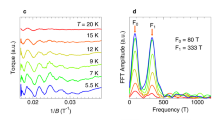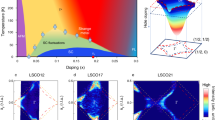Abstract
In high-temperature cuprate superconductors, the superconducting transition temperature (Tc) depends on the number of CuO2 planes in the structural unit and the maximum Tc is realized in the trilayer system. Trilayer superconductors also exhibit an unusual phase diagram where Tc is roughly constant in the overdoped region, which is in contrast to the decrease usually found in other cuprate superconductors. The mechanism for these two effects remains unclear. Here we report features in the electronic structure of Bi2Sr2Ca2Cu3O10+δ superconductor that helps to explain this issue. Our angle-resolved photoemission spectroscopy measurements show the splitting of bands from the three layers, and this allows us to parameterize a three-layer interaction model that effectively describes the data. This, in turn, demonstrates the electronic origin of the maximum Tc and its persistence in the overdoped region. These results are qualitatively consistent with a composite picture where a high Tc is realized in an array of coupled planes with different doping levels such that a high pairing strength is derived from the underdoped planes, whereas a large phase stiffness comes from the optimally or overdoped ones.
This is a preview of subscription content, access via your institution
Access options
Access Nature and 54 other Nature Portfolio journals
Get Nature+, our best-value online-access subscription
$29.99 / 30 days
cancel any time
Subscribe to this journal
Receive 12 print issues and online access
$209.00 per year
only $17.42 per issue
Buy this article
- Purchase on Springer Link
- Instant access to full article PDF
Prices may be subject to local taxes which are calculated during checkout




Similar content being viewed by others
Data availability
All raw data generated during the study are available from the corresponding author upon request.
Code availability
The codes used for the fitting and simulation process in this study are available from the corresponding author upon request.
References
Lee, P. A., Nagaosa, N. & Wen, X. G. Doping a Mott insulator: physics of high-temperature superconductivity. Rev. Mod. Phys. 78, 17 (2006).
Keimer, B., Kivelson, S. A., Norman, M. R., Uchida, S. & Zaanen, J. From quantum matter to high-temperature superconductivity in copper oxides. Nature 518, 179–186 (2015).
Scott, B. A. et al. Layer dependence of the superconducting transition temperature of HgBa2Can−1CunO2n+2+δ. Phys. C 230, 239–245 (1994).
Chakravarty, S., Kee, H.-Y. & Volker, K. An explanation for a universality of transition temperatures in families of copper oxide superconductors. Nature 428, 53–55 (2004).
Iyo, A. et al. Tc vs n relationship for multilayered high-Tcsuperconductors.J. Phys. Soc. Jpn 76, 094711 (2007).
Eisaki, H. et al. Effect of chemical inhomogeneity in bismuth-based copper oxide superconductors. Phys. Rev. B 69, 064512 (2004).
Chu, C. W., Deng, L. Z. & Lv, B. Hole-doped cuprate high temperature superconductors. Phys. C 514, 290–313 (2015).
Fujii, T., Terasaki, I., Watanabe, T. & Matsuda, A. Doping dependence of anisotropic resistivities in the trilayered superconductor Bi2Sr2Ca2Cu3O10+δ. Phys. Rev. B 66, 024507 (2002).
Piriou, A., Fasano, Y., Giannini, E. & Fischer, Ø. Effect of oxygen-doping on Bi2Sr2Ca2Cu3O10+δ vortex matter: crossover from electromagnetic to Josephson interlayer coupling. Phys. Rev. B 77, 184508 (2008).
Muller, R. et al. Fermi surface and superconducting gap of triple-layered Bi2Sr2Ca2Cu3O10+δ. J. Supercond. 15, 147–152 (2002).
Feng, D. L. et al. Electronic structure of the trilayer cuprate superconductor Bi2Sr2Ca2Cu3O10+δ. Phys. Rev. Lett. 88, 107001 (2002).
Sato, T. et al. Low energy excitation and scaling in Bi2Sr2Can−1CunO2n+4(n = 1−3): angle-resolved photoemission spectroscopy. Phys. Rev. Lett. 89, 067005 (2002).
Matsui, H. et al. BCS-like Bogoliubov quasiparticles in high-Tc superconductors observed by angle-resolved photoemission spectroscopy. Phys. Rev. Lett. 90, 217002 (2003).
Ideta, S. et al. Enhanced superconducting gaps in the trilayer high-temperature Bi2Sr2Ca2Cu3O10+δ cuprate superconductor. Phys. Rev. Lett. 104, 227001 (2010).
Ideta, S. et al. Angle-resolved photoemission study of the tri-layer high-Tc superconductor Bi2Sr2Ca2Cu3O10+δ: effects of inter-layer hopping. Phys. C 470, S14 (2010).
Ideta, S. et al. Energy scale directly related to superconductivity in high-Tc cuprates: universality from the temperature-dependent angle-resolved photoemission of Bi2Sr2Ca2Cu3O10+δ. Phys. Rev. B 85, 104515 (2012).
Kunisada, S. et al. Observation of Bogoliubov band hybridization in the optimally doped trilayer Bi2Sr2Ca2Cu3O10+δ. Phys. Rev. Lett. 119, 217001 (2017).
Ideta, S. et al. Hybridization of Bogoliubov quasiparticles between adjacent CuO2 layers in the triple-layer cuprate Bi2Sr2Ca2Cu3O10+δ studied by angle-resolved photoemission spectroscopy. Phys. Rev. Lett. 127, 217004 (2021).
Camargo-Martínez, J. A., Espitia, D. & Baquero, R. First-principles study of electronic structure of Bi2Sr2Ca2Cu3O10. Rev. Mex. Fis. 60, 39–45 (2014).
Feng, D. L. et al. Bilayer splitting in the electronic structure of heavily overdoped Bi2Sr2CaCu2O8+δ. Phys. Rev. Lett. 86, 5550 (2001).
Chuang, Y.-D. et al. Doubling of the bands in overdoped Bi2Sr2CaCu2O8+δ: evidence for c-axis bilayer coupling. Phys. Rev. Lett. 87, 117002 (2001).
Bogdanov, P. V. et al. Photoemission study of Pb doped Bi2Sr2CaCu2O8+δ: a Fermi surface picture. Phys. Rev. B 64, 180505(R) (2001).
Ai, P. et al. Distinct superconducting gap on two bilayer-split Fermi surface sheets in Bi2Sr2CaCu2O8+δ superconductor. Chinese Phys. Lett. 36, 067402 (2019).
Markiewicz, R. S., Sahrakorpi, S., Lindroos, M., Lin, H. & Bansil, A. One-band tight-binding model parametrization of the high-Tc cuprates including the effect of kz dispersion. Phys. Rev. B 72, 054519 (2005).
Yu, Y. J. et al. High-temperature superconductivity in monolayer Bi2Sr2CaCu2O8+δ. Nature 575, 156 (2019).
Pavarini, E., Dasgupta, I., Dasgupta, T. S., Jepsen, O. & Andersen, O. K. Band-structure trend in hole-doped cuprates and correlation with Tcmax. Phys. Rev. Lett. 87, 047003 (2001).
Zhong, Y. G. et al. Extraction of tight binding parameters from in-situ ARPES on the continuously doped surface of cuprates. Sci. China Phys. Mech. Astron. 61, 127403 (2018).
Mori, M., Tohyama, T. & Maekawa, S. Fermi surface splittings in multilayered high-Tc cuprates.Phys. C 445, 23–25 (2006).
Nishiguchi, K., Kuroki, K., Arita, R., Oka, T. & Aoki, H. Superconductivity assisted by interlayer pair hopping in multilayered cuprates. Phys. Rev. B 88, 014509 (2013).
Kivelson, S. A. Making high Tc higher: a theoretical proposal. Phys. B 318, 61–67 (2002).
Berg, E., Orgad, D. & A. Kivelson, S. Route to high-temperature superconductivity in composite systems. Phys. Rev. B 78, 094509 (2008).
Okamoto, S. & Maier, T. A. Enhanced superconductivity in superlattices of high-Tc cuprates. Phys. Rev. Lett. 101, 156401 (2008).
Emery, V. J. & Kivelson, S. A. Importance of phase fluctuations in superconductors with small superfluid density. Nature 374, 434–437 (1995).
Uemura, Y. J. et al. Universal correlations between Tc and ns/m* (carrier density over effective mass) in high-Tc cuprate superconductors. Phys. Rev. Lett. 62, 2317 (1989).
Božović, I., He, X., Wu, J. & Bollinger, A. T. Dependence of the critical temperature in overdoped copper oxides on superfluid density. Nature 536, 309–311 (2016).
Feng, D. L. et al. Signature of superfluid density in the single-particle excitation spectrum of Bi2Sr2CaCu2O8+δ. Science 289, 277–281 (2000).
Ding, H. et al. Coherent quasiparticle weight and its connection to high-Tc superconductivity from angle-resolved photoemission. Phys. Rev. Lett. 87, 227001 (2001).
Liang, B., Lin, C. T., Shang, P. & Yang, G. Single crystals of triple-layered cuprates Bi2Sr2Ca2Cu3O10+δ: growth, annealing and characterization. Phys. C 383, 75–88 (2002).
Liu, G. D. et al. Development of a vacuum ultraviolet laser-based angle-resolved photoemission system with a superhigh energy resolution better than 1meV. Rev. Sci. Instrum. 79, 023105 (2008).
Zhou, X. J. et al. New developments in laser-based photoemission spectroscopy and its scientific applications: a key issues review. Rep. Prog. Phys. 81, 062101 (2018).
Acknowledgements
This work is supported by the National Natural Science Foundation of China (grant nos. 11888101 (to X.J.Z.), 11922414 (to L.Z.) and 11974404 (to G.L.)), the National Key Research and Development Program of China (grant nos. 2021YFA1401800 (to X.J.Z.), 2017YFA0302900 (to T.X.) and 2018YFA0305600 (to G.L.)), the Strategic Priority Research Program (B) of the Chinese Academy of Sciences (grant no. XDB25000000 (to X.J.Z.)), Innovation Program for Quantum Science and Technology (grant no. 2021ZD0301800 (to X.J.Z.)), the Youth Innovation Promotion Association of CAS (grant no. Y2021006 (to L.Z.)) and the Synergetic Extreme Condition User Facility (SECUF).
Author information
Authors and Affiliations
Contributions
X.J.Z. and X.L. proposed and designed the research. X.L., H.C., C.Y., Q.G. and H.Y. carried out the ARPES experiments. C.L. grew the single crystals. H.C., C.Y., T.M., H.L., Y.S., Y.C., S.Z., Z.W., F.Z., F.Y., Q.P., G.L., L.Z., Z.X. and X.J.Z. contributed to the development and maintenance of the laser ARPES and ARTOF systems. X.L., Y.L., Q.G. and T.X. contributed to the theoretical analysis. X.L. and X.J.Z. analysed the data and wrote the paper. All authors participated in the discussions and commented on the paper.
Corresponding author
Ethics declarations
Competing interests
The authors declare no competing interests.
Peer review
Peer review information
Nature Physics thanks Robert Markiewicz and the other, anonymous, reviewer(s) for their contribution to the peer review of this work.
Additional information
Publisher’s note Springer Nature remains neutral with regard to jurisdictional claims in published maps and institutional affiliations.
Supplementary information
Supplementary Information
Supplementary Sections 1–9, Figs. 1–10 and Equations (1)–(12).
Source Data Fig. 3
Statistical source data.
Source Data Fig. 4
Statistical source data.
Rights and permissions
Springer Nature or its licensor (e.g. a society or other partner) holds exclusive rights to this article under a publishing agreement with the author(s) or other rightsholder(s); author self-archiving of the accepted manuscript version of this article is solely governed by the terms of such publishing agreement and applicable law.
About this article
Cite this article
Luo, X., Chen, H., Li, Y. et al. Electronic origin of high superconducting critical temperature in trilayer cuprates. Nat. Phys. 19, 1841–1847 (2023). https://doi.org/10.1038/s41567-023-02206-0
Received:
Accepted:
Published:
Issue Date:
DOI: https://doi.org/10.1038/s41567-023-02206-0
This article is cited by
-
Three is the optimal number
Nature Physics (2023)



